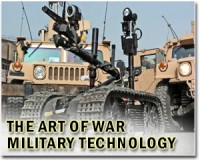| . |  |
. |
Washington (AFP) Nov 30, 2010 It looks and acts like something best left in the hands of Sylvester Stallone's "Rambo," but this latest dream weapon is real -- and the US Army sees it becoming the Taliban's worst nightmare. The Pentagon has rolled out prototypes of its first-ever programmable "smart" grenade launcher, a shoulder-fired weapon that uses microchipped ammunition to target and kill the enemy, even when the enemy is hidden behind walls or other cover. After years of development, the XM25 Counter Defilade Target Engagement System, about the size of a regular rifle, has now been deployed to US units on the battlefields of Afghanistan, where the Army expects it to be a "game-changer" in its counterinsurgency operations. "For well over a week, it's been actively on patrols, and in various combat outposts in areas that are hot," said Lieutenant Colonel Chris Lehner, program manager for the XM25. The gun's stats are formidable: it fires 25mm air-bursting shells up to 2,300 feet (700 meters), well past the range of most rifles used by today's soldiers, and programs them to explode at a precise distance, allowing troops to neutralize insurgents hiding behind walls, rocks or trenches or inside buildings. "This is the first time we're putting smart technology into the hands of the individual soldier," Lehner told AFP in a telephone interview. "It's giving them the edge," he said, in the harsh Afghan landscape where Islamist extremists have vexed US troops using centuries-old techniques of popping up from behind cover to engage. "You get behind something when someone is shooting at you, and that sort of cover has protected people for thousands of years," Lehner said. "Now we're taking that away from the enemy forever." PEO Soldier says studies show the XM25 is 300 percent more effective than current weapons at the squad level. The revolutionary advance involves an array of sights, sensors and lasers that reads the distance to the target, assesses elements such as air pressure, temperature, and ballistics and then sends that data to the microchip embedded in the XM25 shell before it is launched. Previous grenade launchers needed to arc their shells over cover and land near the target to be effective. "It takes out a lot of the variables that soldiers have to contemplate and even guess at," Lehner said. If, for example, an enemy combatant pops up from behind a wall to fire at US troops and then ducks behind it, an XM25 gunner can aim the laser range finder at the top of the wall, then program the shell to detonate one meter beyond it, showering lethal fragmentation where the insurgent is seeking cover. Use of the XM25 can slash civilian deaths and damage, the Army argues, because its pinpointed firepower offers far less risk than larger mortars or air strikes. The result, the Army says, is "very limited collateral damage." The Pentagon plans to purchase at least 12,500 of the guns -- at a price tag of 25,000 to 30,000 dollars each -- beginning next year, enough for one in each Infantry squad and Special Forces team. Lehner said the XM25 was special in that it requires comparatively little training, because the high-powered technology does so much of the work. "This system is turning soldiers with average shooting skills into those with phenomenal shooting skills," he said.
Share This Article With Planet Earth
Related Links The latest in Military Technology for the 21st century at SpaceWar.com
 Myanmar now the only active landmine user: campaigners
Myanmar now the only active landmine user: campaignersGeneva (AFP) Nov 24, 2010 Myanmar is now the only government still laying landmines after Russia stopped using such weapons, campaigners said Wednesday, noting that 2009 marked the lowest usage of the deadly explosives in a decade. The International Campaign to Ban Landmines (ICBL) credited the 1997 Ottawa international treaty banning anti-personnel mines for the reduction in usage. "Although no additional countr ... read more |
|
| The content herein, unless otherwise known to be public domain, are Copyright 1995-2010 - SpaceDaily. AFP and UPI Wire Stories are copyright Agence France-Presse and United Press International. ESA Portal Reports are copyright European Space Agency. All NASA sourced material is public domain. Additional copyrights may apply in whole or part to other bona fide parties. Advertising does not imply endorsement,agreement or approval of any opinions, statements or information provided by SpaceDaily on any Web page published or hosted by SpaceDaily. Privacy Statement |